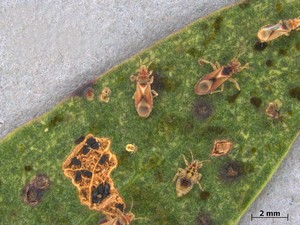Fighting the invaders
 Our forest protection team has been working with the Ministry for Primary Industries (MPI) to eradicate the spread of the Eucalyptus leaf beetle, Paropsisterna beata, a recent invader of New Zealand forests. The beetle defoliates tree canopy, reducing growth rate and subsequent pulp production. If left unchecked, MPI estimates it could potentially cost the pulp industry millions of dollars annually in lost production.
Our forest protection team has been working with the Ministry for Primary Industries (MPI) to eradicate the spread of the Eucalyptus leaf beetle, Paropsisterna beata, a recent invader of New Zealand forests. The beetle defoliates tree canopy, reducing growth rate and subsequent pulp production. If left unchecked, MPI estimates it could potentially cost the pulp industry millions of dollars annually in lost production. The team has developed an effective spray programme suitable to the terrain and canopy conditions, using the AGDISP spray deposition model (see following article). The beetle is restricted to a small valley near Upper Hutt and scientists expect it to be eradicated after the spring treatment.
Our diagnostic laboratory also identified a new to New Zealand insect that has the potential to be another significant pest of eucalypts. The bronze bug, Thaumastocoris peregrinus, is a sap feeder causing leaf discoloration, or ‘winter bronzing’, which can lead to premature leaf drop and branch death. Potential hosts of the bug include over 30 eucalypt species; the most severely affected to date appears to be the popular amenity tree, Eucalyptus nicholi. Scion is reviewing biological control options and continuing to research the bug’s ecology.
